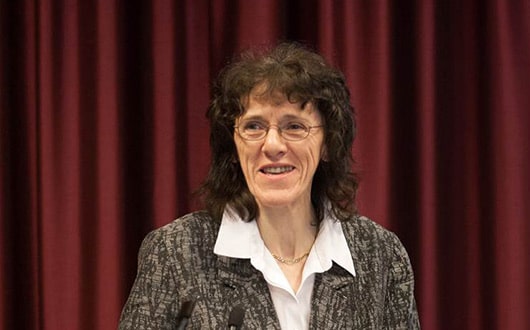Posted on April 4, 2016 in ASRC News
Dr. Gillian Small, CUNY Vice Chancellor for Research and Executive Director of the CUNY Advanced Science Research Center (ASRC), discussed the research innovations taking place within CUNY and at the ASRC during a presentation to the Society for College & University Planning’s North Atlantic Regional Conference on Monday, March 21 at The New School. And, addressing changes in the scientific research environment paradigm in the 21st century, Small spoke about the concerted effort made by CUNY to position itself as a national and world leader in cutting-edge research.

Along with David Halpern, Architect with Flad Architects, and Hana Hassem, Director of Kohn Pedersen Fox Associates, Small talked extensively on how laboratory and research building design play an increasingly important role in encouraging interdisciplinary research. The ASRC incorporates many of these design features, including flexible lab space, meeting spaces to encourage interactions between scientists in different disciplines, and strategic core facilities.
Halpern noted that “These uniquely designed public spaces are actually part of the larger project objectives of collaboration, discovery and innovation. They are all about interaction and shouldn’t be considered frivolous or inconsistent with the larger mission. In fact, studies have shown that premium costs associated with spaces promoting interaction have yielded returns in greater researcher output and increased retention”
“Every aspect of the ASRC was strategically chosen to allow researchers at the center to address the most pressing challenges in their fields through collaborations across disciplines,” Small said. “In coordination with the City College of New York’s Center for Discovery and Innovation, CUNY researchers have the resources to work closely and innovatively with others in the wider scientific community.”
In addition to its goal of encouraging interdisciplinary research, the ASRC also has a stated mission of researching science in the public interest—and to interesting the public in science. To this end, the ASRC will be opening its Science Education & Discovery Center museum space in late 2016/early 2017—an integral part of the ASRC’s robust education and public outreach program.
“An essential component of the ASRC’s mission is to inspire young people to pursue careers in the sciences and to develop a more scientifically literate general population,” Small said. “By emphasizing the human element of cutting-edge research, ASRC scientists will help contextualize much of what visitors learned in the Science Discovery & Education Center.”
###
About the ASRC: The CUNY Advanced Science Research Center (ASRC) is a University-wide venture that elevates CUNY’s legacy of scientific research and education through initiatives in five distinctive, but increasingly interconnected disciplines: Nanoscience, Photonics, Structural Biology, Neuroscience and Environmental Sciences. Led by Dr. Gillian Small, Vice Chancellor for Research and the ASRC’s executive director, the center is designed to promote a unique, interdisciplinary research culture. Researchers from each of the initiatives work side by side in the ASRC’s core facilities, sharing equipment that is among the most advanced available. Funding for the ASRC from New York State is gratefully acknowledged.
###
